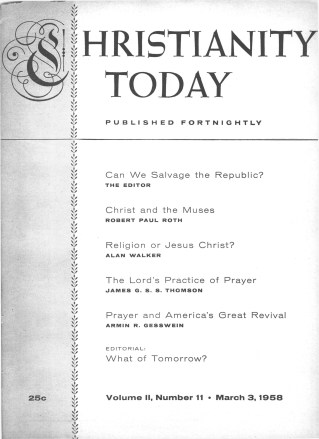What is perhaps the most widely known and loved pictorial presentation of Christ, at least among Protestants, is what has become popularly known in the last 25 years as Sallman’s Head of Christ.
Adverse criticism has stalked the rise of Sallman’s work continually. Some art experts have found fault with the painting even as it was becoming world-famous. First its originality was challenged, then its stature as true art.
Now there are more misgivings. Even if the work is original, even if it has inspirational qualities founded in evangelical piety, a further question is posed: Does the work represent authentic Christian art?
Warner E. Sallman, now 65, is a humble commercial artist, of Mission Covenant church background. His Christian devotion is forthright:
“I believe everyone who has committed himself to Christ our Lord desires to serve him with whatever gifts or talents he may possess. On this premise, with Jesus Christ as my guide, it has been my goal to yield whatever abilities God has given me to his honor and glory. It seemed that my talent for painting and illustrating developed in me from early youth, and by divine direction I was led step by step toward a ministry of Christian art. I give God the glory for whatever has been accomplished by my efforts to bring joy and happiness to people throughout the world.”
Sallman did not always want to be an artist. During childhood he had entertained aspirations of being a physician, then a minister. But his bent for art prevailed. Aided by the encouragement and instruction of Christian parents, young Warner Sallman produced his first oil at the age of 10. The young artist’s professional training included night classes at the Chicago Art Institute.
It was while he was attending YMCA Bible lectures that he heard Dr. Charles Ray Goff of Chicago’s Methodist Temple portray Jesus not as a weakling, but as young and vigorous and strong of face and spirit. During a restless January night in 1924, facing a deadline for a magazine cover sketch, the picture emerged that roused Sallman to produce a three-inch charcoal image which eventually became the phenomenally popular Head of Christ.
The work did not gain any remarkable recognition until 1933. Sallman did not paint the Head of Christ in oils until 1940.
The artist’s connections with evangelical Protestantism gave his effort immediate welcome in devout independent and fundamentalist circles. The Kriebel and Bates publishing firm of Indianapolis, Indiana, took up the promotion to achieve even greater success in the major denominations. Public acceptance snowballed.
Nearly 100 million copies of the picture have been sold the world over. Catholics and Protestants alike point to the work as a choice example of contemporary inspirational art. The popularity spilled over so that other Sallman paintings also gained widespread recognition. The artist has produced 20 different settings of Christ.
The attending publicity made Sallman himself world-famous.
Professional Doubt Prevails
A number of artists, however, have never been convinced. It has been 15 years since a former professor of art at Wheaton College questioned the painting’s originality, noting a similarity to Christ of the Humble, by L’Hermitte, now hanging in the Boston Museum of Fine Arts.
Says Dr. DeWitt Jayne, now art director for the American Mercury:
“Sallman didn’t even have the draftsmanship to make a good copy of it.”
It is 34 years after the three-inch sketch was scrawled at a bedside. The latest case against it takes form in a question as to its authentic Christian character. Does Sallman’s Head of Christ actually say, as Kriebel and Bates would have it, that “Christ was, and still is, the solution to every problem, the supplier of every need, and the master of every situation”? Does the painting stand in the tradition of humanism or idealism rather than of evangelical art? Is this another example of Renaissance art, a humanizing of Jesus? Does Christ’s deity shine through his humanity? Is this evangelical art?
Is It “Rugged,” or “Weak”?
The publishers say Sallman has produced an interpretation of Christ as “the more rugged type.” Many critics refuse to accept this.
In the current issue of CHRISTIANITY TODAY, a Lutheran scholar, Dr. Robert Paul Roth, voices one of the sharpest criticisms (page 8): “In Sallman’s Head of Christ we have a pretty picture of a woman with a curling beard who has just come from the beauty parlor with a Halo shampoo, but we do not have the Lord who died and rose again!”
A few weeks ago saw another challenge to the masculine character of the subject. “The most famous picture of Jesus makes him look weak and effeminate,” said Dr. Harold Ehrensperger, professor of religion and creative arts at Boston University School of Theology. “You present this famous picture of Jesus on some of our mission fields,” he said, “and the people say, ‘Your God looks weak.’ ”
Some Christian artists see a lack, but withhold criticism out of deference to the painting’s inspirational values.
“It is accepted by so many Christians that perhaps the Lord is pleased to use it,” says H. Willard Ortlip, associate professor of art at Houghton College. “The same might be said of the lighter Gospel songs.”
Ortlip adds: “Art being the index of contemporary cultures, the Sallman ‘Head’ may well reflect the spiritual depth of popular Christianity today.… The chiaroscuro, borrowed from the L’Hermitte in Boston, gives an attractive quality, but the spiritual values are lacking. For me, it is a perfect projection of the ‘voice’ that spoke the words of Christ in the Oursler program—cold, impassioned, stilted. There’s an idea for the promoter! Why not add to the electric light that accompanies the latest production, a ‘talky’ wire with the Oursler voice?”
Ortlip nevertheless sympathizes with Sallman, describing him as “the victim of high-pressure salesmanship” who “probably was sincere in his original intention.” The professor expresses the prayer that “the Lord may continue to bless the picture to the comfort and inspiration of many.”
Professional courtesy limits more adverse criticism of Sallman than has been made public.
Karl Steele, director of the art department at Wheaton College, also admires the painting’s inspirational qualities.
“I feel that the picture apparently has been the source of inspiration to a great many people,” he says, and that is the extent of his praise.
But if this is not evangelical art, then what is? Or is there any such thing? Here is an evangelical artist who has made a tremendous name for himself. And as such he represents, for better or for worse, conservative Christianity in the area of art. Should not true believers have true artists? Moreover, should not they have true art and true Christian art?
Steele says that herewith evangelicals tread on weak ground. According to him, “there are many fine Chrisdan artists,” but few are getting the opportunity to express themselves.
Steele puts the matter to both the artists and the churches.
“For example,” he says, “Bible illustrations could be fresher and more challenging. Yet the church has been slow to offer encouragement.”
Steele adds a word of caution:
“Art is moving toward content and subject matter. Evangelicals, in trying to catch up, should be careful not to move into an area being vacated.”










